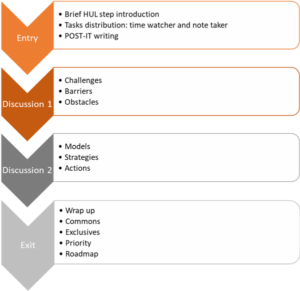In order to facilitate the implementation of the HUL approach, it has been developed a six-step action plan (UNESCO, n.d.). The 6 steps of HUL are:
- mapping resources: natural, cultural, and human;
- reaching consensus on what values and related attributes to protect;
- assessing the vulnerability of the identified values and related attributes to change and development;
- integrating values, related attributes, and their vulnerability in urban development framework;
- prioritizing actions for conservation and development; and
- establishing local partnerships and management frameworks for each of the actions.
Furthermore, four categories of tools have been identified to support the implementation of the HUL approach (UNESCO, n.d.); namely
- civic engagement tools,
- knowledge and planning tools,
- regulatory systems, and
- financial tools.
It is advised to adapt these tools to the local context and develop them during the process with the stakeholders’ involvement (UNESCO, n.d.).
See Prof. dr. Pereira Roders of Eindhoven University of Technology introducing the HUL approach, the six critical step, and the four tools before the round-table session of the HUL workshop held in Amsterdam (HUL approach: from 00:05:54 to 00:06:49; four tools: from 00:14:51 to 00:15:20; six critical steps: from 00:21:18 to 00:28:00).
Within the CLIC project, the HUL workshops aim at involving stakeholders in reflecting on good practices, identifying barriers and bottlenecks, and brainstorming solutions to number up the practice of cultural heritage adaptive reuse and contribute to the transition towards circular cities.
In May 2018 the first of the HUL workshops was held in Amsterdam, the second was hosted by Salerno in November 2018.
Each HUL workshops started with an introductive moment to share information about the hosting city and its adaptive reuse cases. During the introduction, local stakeholders shared information with the workshop participants in order to provide a common ground upon which discussing during the second moment of the HUL workshop. The introductive moment counted a session of presentations and a guided expedition to relevant examples of adaptive reuse
See the session of presentations during the HUL workshop in Salerno (audio in Italian)
The second moment of the HUL workshop demanded the active participation of all stakeholders (local ones and CLIC partners) in round-table discussions. The second moment was structured following the six critical steps of the HUL approach: there were six tables and each one investigated cultural heritage adaptive reuse focusing on a specific HUL critical step. Each table-step had a facilitator acquainted with the Historic Urban Landscape approach.
Each round was divided into four phases (Figure 1), namely: entry, discussion 1, discussion 2, and exit.
After the entry phase, the team members confronted and discussed the challenges, barriers, and obstacles pinpointed. Subsequently, the team addressed the possible strategies to overcome what emerged. The last part of the round was dedicated to wrapping up the results of the discussions, trying to reveal commonalities, variations, exceptions, and priorities as well as indicate roadmaps to tackle the challenges identified.

See the wrap up during the HUL workshop in Amsterdam (from 01:02:33 to 01:38:00)
Last, but not least, a big thank to the stakeholders and the colleagues of the CLIC project who actively took part in the HUL workshops bringing their contributions and making these involvement process possible.
References:
- Ginzarly, C. Houbart & J. Teller (2018). The Historic Urban Landscape approach to urban management: a systematic review, International Journal of Heritage Studies, DOI: 10.1080/13527258.2018.1552615
- UNESCO. (n.d.). UNESCO Recommendation on the Historic Urban Landscape. Retrieved June 26, 2018, from https://whc.unesco.org/en/hul/
- UNESCO. (2011). Recommendation on the Historic Urban Landscape, including a glossary of definitions. Retrieved June 26, 2018, from http://portal.unesco.org/en/ev.php-URL_ID=48857&URL_DO=DO_TOPIC&URL_SECTION=201.html
